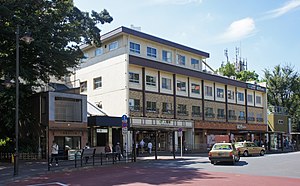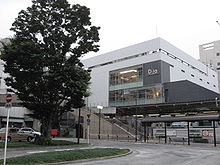Mitaka train station
| Mitaka Train Station ( 三 鷹 ) | |
|---|---|
|
North entrance (September 2019)
|
|
| Data | |
| Location in the network | Through station |
| Platform tracks | 6th |
| abbreviation | JB01 / JC12 |
| opening | June 25, 1930 |
| location | |
| City / municipality | Mitaka |
| prefecture | Tokyo |
| Country | Japan |
| Coordinates | 35 ° 42 '10 " N , 139 ° 33' 40" E |
| Height ( SO ) | 60 m TP |
| Railway lines | |
| List of train stations in Japan | |
The Mitaka Station ( Jap. 三鷹駅 , Mitaka-eki ) is a station on the Japanese island of Honshu . It is operated by the JR East Railway Company and is located in Tokyo Prefecture in the Tachikawa City area .
links
Mitaka is a through station on the Chūō main line from Tokyo via Shinjuku to Shiojiri , the tracks of which are identical to those of the Chūō high-speed train line (Tokyo – Shinjuku – Takao ). Mitaka is also the western terminus of the partially parallel Chūō-Sōbu line via Akihabara to Chiba . All three lines are operated by the JR East railway company. Between Mitaka and Nakano the SOBU Chuo-line is underground trains on the company Tokyo Metro shared leading to the Tozai-line by Nishi Funabashi- and Tsudanuma by bound are.
A pair of Narita Express trains ( 成 田 エ ク ス プ レ ス ), which connects Takao with Tokyo Narita Airport , stop in Mitaka every day . In addition, three pairs of express trains of the Holiday Rapid Okutama from Shinjuku via Tachikawa to Oku-Tama (or as Holiday Rapid Akigawa to Musashi-Itsukaichi ) stop on weekends and public holidays . The regional traffic on the Chūō rapid transit line is very dense and consists of a complex system of express and local trains with train schedules of a few minutes. The starting points are usually Tokyo in the east and Takao and Ōtsuki in the west. Some trains run beyond Ōtsuki to Kawaguchiko or switch to the Ōme line in Tachikawa .
Local traffic through the inner Tokyo suburbs east of Mitaka is handled on the Chūō-Sōbu line, which has its own tracks and is operationally independent of the other two lines. During rush hour, the train sequence is only two minutes, with several trains running further west to Musashi-Koganei and only turning there. During the day, nine trains are offered every hour. Except during the morning rush hour and in the late evening, up to five subways of the Tōzai line run every hour via the nominal terminus Nakano to Mitaka.
There are large bus terminals with several stops on both the northern and southern station forecourt . These are served by around 50 lines of the companies Kantō Bus , Keiō Dentetsu Bus , Mubus , Odakyū Bus and Seibu Bus as well as the city bus company Mitaka. The so-called cat buses ( 猫 バ ス Neko basu ) go to Studio Ghibli's museum and are based on the anime My Neighbor Totoro with corresponding designs.
investment
The station is on the city limits between Mitaka and Musashino , with the area of the northern station forecourt belonging to the neighboring city. The "Statue of the World Federation of Peace" ( 世界 連邦 平和 像 , Sekai Rempō Heiwa-zō ) by Kitamura Seibō has stood there since 1969 . Furthermore, the Musashino Performing Arts Theater , the Hiranuma Garden as well as the town hall and other public buildings of the city of Musashino can be reached via the northern exit . The southern exit leads to Mitaka City facilities. These include the City Hall, the Municipal Art Gallery, the Yamamoto Yūzō Memorial, and the Ghibli Museum .
The facility is oriented from east to west and has seven tracks, six of which are used for passenger traffic. These are located on three covered central platforms . The four tracks on the two northern platforms are reserved for high-speed and long-distance traffic, the two tracks on the southern platform for local traffic. A single track on the southern edge ends bluntly coming from the west and serves as a reserve. While the railway line east of the station has four tracks, it narrows to two tracks to the west. The over the resort spans reception building in the form of a wide Reiter station . Above it rises the Atrevi Mitaka shopping center , to which the Dila Mitaka shopping arcade is attached. Both are owned by a subsidiary of JR East. A little more than half a kilometer west of the station is the Mitaka depot with a large depot .
In the 2018 fiscal year, an average of 98,707 passengers used the station every day.
Tracks
| 1 • 2 | ▉ Chūō-Sōbu line | Nakano • Shinjuku • Akihabara • Nishi-Funabashi • Chiba |
|
|
Looped trains to Nakano • Iidabashi • Ōtemachi • Nishi-Funabashi • Tsudanuma | |
| 3 • 4 | ▉ Chūō rapid transit line | Tachikawa • Hachiōji • Takao |
| 5 • 6 | ▉ Chūō rapid transit line | Nakano • Shinjuku • Tokyo |
history
The Chūō main line had already been opened in 1889 by the private railway company Kōbu Tetsudō , but the trains initially drove without stopping for three and a half decades. Three months after the Ministry of Railways opened the Mitaka depot, it set up a signaling station on September 1, 1929. Further expansion resulted in a regular train station, which opened on June 25, 1930.
On July 15, 1949, two weeks after the founding of the Japanese State Railways , the station was the scene of the so-called «Mitaka incident» ( 三 鷹 事件 , Mitaka-jiken ). An unoccupied train drove towards the station at high speed and hit six people who got under the wagons and died. The train derailed and bored into the street in front of the station, where it injured another 20 people. This serious accident resulted in a famous criminal case in post-war Japan. The government charged ten people with fatal sabotage. She claimed that communist members of the National Railway Workers' Union were responsible for the accident. The judgment passed in 1955 in the criminal trial against the ten defendants resulted in nine acquittals and one final death sentence. However, this was never carried out due to the death of the convicted person from a brain tumor.
From April 14, 1951 to November 1, 1959, the state railway operated a 3.2 km long branch line from Mitaka to the temporary Musashino baseball stadium. In the following years she significantly expanded the station. This included replacing the previous reception building with a riding station and expanding the Ogikubo – Mitaka section from two to four tracks. The new systems went into operation on April 6, 1969. As part of the privatization of the state railway, the station passed into the possession of the new railway company JR East on April 1, 1987 . The new owner began to develop the area south of the train station into a densely built-up business district. The Neocity Mitaka car park was ready for occupancy in 1993, and in 1999 the Crescent City Mitaka high-rise and the Atrevi Mitaka shopping center were added. On December 16, 2007, the first construction phase of the Dila Mitaka was completed, in April 2008 the second construction phase .
Adjacent train stations
|
←
|
Lines |
→
|
||
|---|---|---|---|---|
| Kichijōji |
|
Musashi-Sakai | ||
| Kichijōji |
|
The End | ||
Web links
- JR East Station Information (Japanese)
Individual evidence
- ↑ a b JR 時刻表 2019 年 3 月 号 (JR timetable March 2019). Kōtsū shinbunsha, Tokyo 2019.
- ↑ 各 駅 の 乗車 人員. JR East , 2018, accessed December 10, 2019 (Japanese).
- ↑ Kyoko Horikawa: 教誨 師 . Kōdansha, Bunkyō 2014, ISBN 4-06-218741-8 , pp. 183-187 .
- ↑ 中央 本 線 三 鷹 ・ 武 蔵 野 競技場 前 間 の 運輸 営 業 は 廃 止 す る 件 (Public Notice No. 386). Japanese State Railways , October 26, 1959.
- ↑ Tetsu Ishino (Ed.): 停車場 変 遷 大事 典 国 鉄 ・ JR 編 (station change directory JNR / JR) . JTB, Tokyo 1998, ISBN 978-4-533-02980-6 .
- ↑ 2007 年 12 月 16 日 (日), JR 三 鷹 駅 に エ キ ナ カ 商業 空間 「Dila (デ ィ ラ) 三 鷹」 (I 期) が 開業 し ま す. (PDF, 1.8 MB) JR East , October 25, 2007, accessed December 10, 2019 (Japanese).




